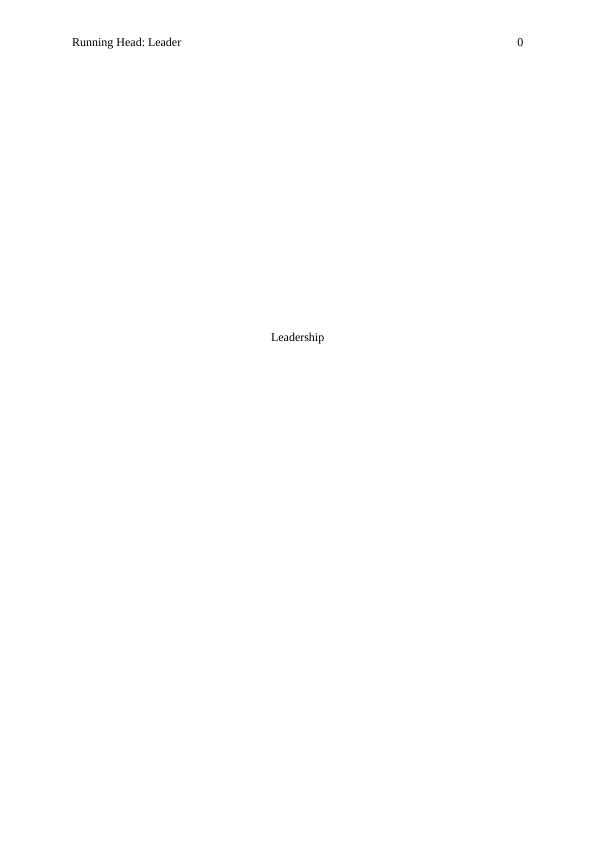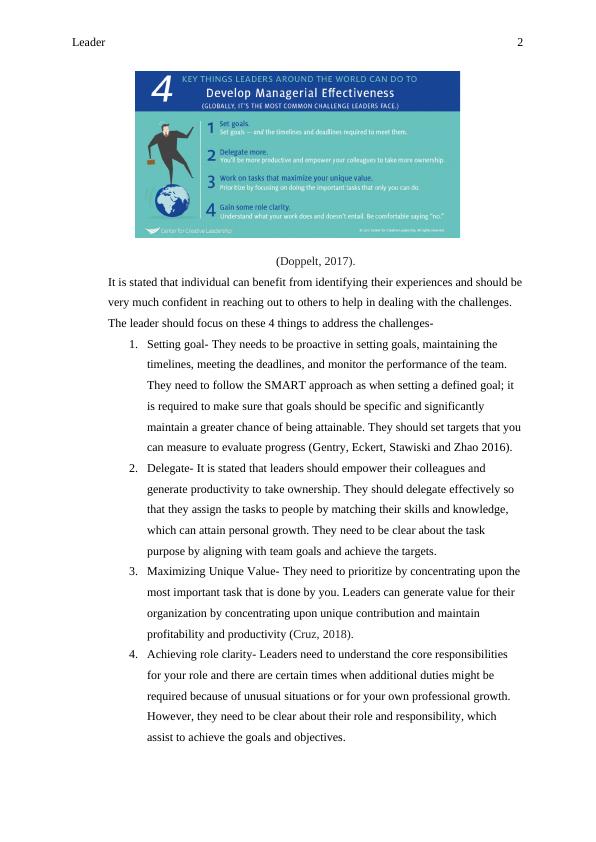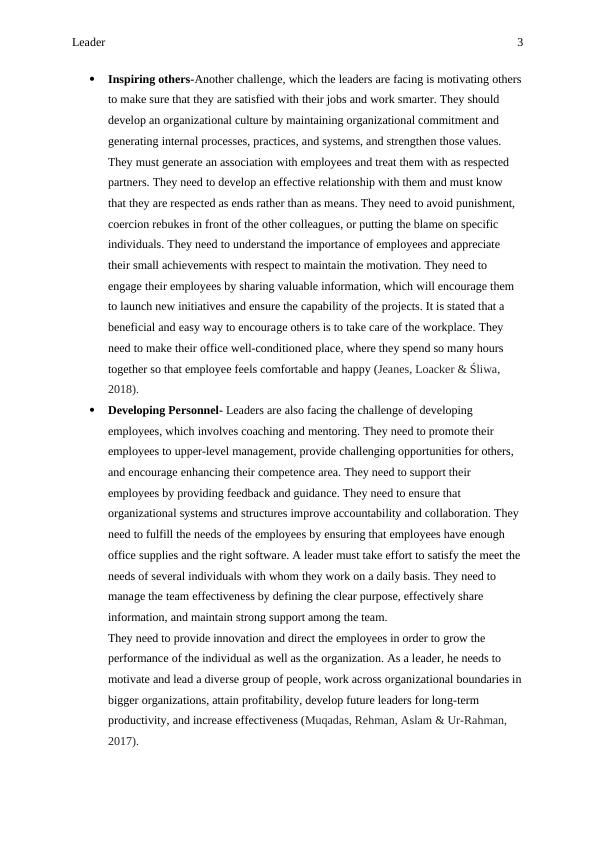Challenges of Leading an Organization: Strategies for Success
Added on 2022-12-26
11 Pages3692 Words56 Views
Running Head: Leader 0
Leadership
Leadership

Leader 1
In today’s globalized world, no organization wants to be stagnant and individual
wants to develop and grow their business in several parts of the world. The dynamic
workforce of the Australian Organizations brings the understanding about the trends, thinking
of different people, work culture, and practices, which can assist the organization in
developing faster by adopting the ideas, which seems profitable. Organizations in Australia
believes in a diverse workforce and concentrates on transforming the old practices by
persuading the individual and organizational behaviour towards the enhanced practices. In
today’s rising world developing globalization, it is very difficult to hire, retain, and motivate
the productive employees in the organization. Australian business induces more foreign
investment and several Australian companies are transforming into MNC’s now. It is stated
that Australia delivers a healthy environment for the application of diverse workforce, which
comes with challenges and are directly related with the personnel working in the organization
(Legner, Eymann, Hess, Matt, Böhmann, Drews & Ahlemann, 2017).
Challenges of leading an organization
The life of a modern-day leader is not easy so it is necessary to lead and encourage a
diversified number of individuals, enhance efficiency, attain growth & profitability, and work
across organizational boundaries. They deal with a globalized and complex environment,
manage competitors, fulfil the requirement of the government, and meet the needs of other
shareholders (Erdman, 2018). Several challenges, which have been faced in leading an
organization are-
Developing Managerial Effectiveness- The main challenge faced by leaders is
developing the significant skills such as strategic thinking, prioritization, and
decision-making, getting up to speed with the job, and time management to be more
efficient at work.
In today’s globalized world, no organization wants to be stagnant and individual
wants to develop and grow their business in several parts of the world. The dynamic
workforce of the Australian Organizations brings the understanding about the trends, thinking
of different people, work culture, and practices, which can assist the organization in
developing faster by adopting the ideas, which seems profitable. Organizations in Australia
believes in a diverse workforce and concentrates on transforming the old practices by
persuading the individual and organizational behaviour towards the enhanced practices. In
today’s rising world developing globalization, it is very difficult to hire, retain, and motivate
the productive employees in the organization. Australian business induces more foreign
investment and several Australian companies are transforming into MNC’s now. It is stated
that Australia delivers a healthy environment for the application of diverse workforce, which
comes with challenges and are directly related with the personnel working in the organization
(Legner, Eymann, Hess, Matt, Böhmann, Drews & Ahlemann, 2017).
Challenges of leading an organization
The life of a modern-day leader is not easy so it is necessary to lead and encourage a
diversified number of individuals, enhance efficiency, attain growth & profitability, and work
across organizational boundaries. They deal with a globalized and complex environment,
manage competitors, fulfil the requirement of the government, and meet the needs of other
shareholders (Erdman, 2018). Several challenges, which have been faced in leading an
organization are-
Developing Managerial Effectiveness- The main challenge faced by leaders is
developing the significant skills such as strategic thinking, prioritization, and
decision-making, getting up to speed with the job, and time management to be more
efficient at work.

Leader 2
(Doppelt, 2017).
It is stated that individual can benefit from identifying their experiences and should be
very much confident in reaching out to others to help in dealing with the challenges.
The leader should focus on these 4 things to address the challenges-
1. Setting goal- They needs to be proactive in setting goals, maintaining the
timelines, meeting the deadlines, and monitor the performance of the team.
They need to follow the SMART approach as when setting a defined goal; it
is required to make sure that goals should be specific and significantly
maintain a greater chance of being attainable. They should set targets that you
can measure to evaluate progress (Gentry, Eckert, Stawiski and Zhao 2016).
2. Delegate- It is stated that leaders should empower their colleagues and
generate productivity to take ownership. They should delegate effectively so
that they assign the tasks to people by matching their skills and knowledge,
which can attain personal growth. They need to be clear about the task
purpose by aligning with team goals and achieve the targets.
3. Maximizing Unique Value- They need to prioritize by concentrating upon the
most important task that is done by you. Leaders can generate value for their
organization by concentrating upon unique contribution and maintain
profitability and productivity (Cruz, 2018).
4. Achieving role clarity- Leaders need to understand the core responsibilities
for your role and there are certain times when additional duties might be
required because of unusual situations or for your own professional growth.
However, they need to be clear about their role and responsibility, which
assist to achieve the goals and objectives.
(Doppelt, 2017).
It is stated that individual can benefit from identifying their experiences and should be
very much confident in reaching out to others to help in dealing with the challenges.
The leader should focus on these 4 things to address the challenges-
1. Setting goal- They needs to be proactive in setting goals, maintaining the
timelines, meeting the deadlines, and monitor the performance of the team.
They need to follow the SMART approach as when setting a defined goal; it
is required to make sure that goals should be specific and significantly
maintain a greater chance of being attainable. They should set targets that you
can measure to evaluate progress (Gentry, Eckert, Stawiski and Zhao 2016).
2. Delegate- It is stated that leaders should empower their colleagues and
generate productivity to take ownership. They should delegate effectively so
that they assign the tasks to people by matching their skills and knowledge,
which can attain personal growth. They need to be clear about the task
purpose by aligning with team goals and achieve the targets.
3. Maximizing Unique Value- They need to prioritize by concentrating upon the
most important task that is done by you. Leaders can generate value for their
organization by concentrating upon unique contribution and maintain
profitability and productivity (Cruz, 2018).
4. Achieving role clarity- Leaders need to understand the core responsibilities
for your role and there are certain times when additional duties might be
required because of unusual situations or for your own professional growth.
However, they need to be clear about their role and responsibility, which
assist to achieve the goals and objectives.

Leader 3
Inspiring others-Another challenge, which the leaders are facing is motivating others
to make sure that they are satisfied with their jobs and work smarter. They should
develop an organizational culture by maintaining organizational commitment and
generating internal processes, practices, and systems, and strengthen those values.
They must generate an association with employees and treat them with as respected
partners. They need to develop an effective relationship with them and must know
that they are respected as ends rather than as means. They need to avoid punishment,
coercion rebukes in front of the other colleagues, or putting the blame on specific
individuals. They need to understand the importance of employees and appreciate
their small achievements with respect to maintain the motivation. They need to
engage their employees by sharing valuable information, which will encourage them
to launch new initiatives and ensure the capability of the projects. It is stated that a
beneficial and easy way to encourage others is to take care of the workplace. They
need to make their office well-conditioned place, where they spend so many hours
together so that employee feels comfortable and happy (Jeanes, Loacker & Śliwa,
2018).
Developing Personnel- Leaders are also facing the challenge of developing
employees, which involves coaching and mentoring. They need to promote their
employees to upper-level management, provide challenging opportunities for others,
and encourage enhancing their competence area. They need to support their
employees by providing feedback and guidance. They need to ensure that
organizational systems and structures improve accountability and collaboration. They
need to fulfill the needs of the employees by ensuring that employees have enough
office supplies and the right software. A leader must take effort to satisfy the meet the
needs of several individuals with whom they work on a daily basis. They need to
manage the team effectiveness by defining the clear purpose, effectively share
information, and maintain strong support among the team.
They need to provide innovation and direct the employees in order to grow the
performance of the individual as well as the organization. As a leader, he needs to
motivate and lead a diverse group of people, work across organizational boundaries in
bigger organizations, attain profitability, develop future leaders for long-term
productivity, and increase effectiveness (Muqadas, Rehman, Aslam & Ur-Rahman,
2017).
Inspiring others-Another challenge, which the leaders are facing is motivating others
to make sure that they are satisfied with their jobs and work smarter. They should
develop an organizational culture by maintaining organizational commitment and
generating internal processes, practices, and systems, and strengthen those values.
They must generate an association with employees and treat them with as respected
partners. They need to develop an effective relationship with them and must know
that they are respected as ends rather than as means. They need to avoid punishment,
coercion rebukes in front of the other colleagues, or putting the blame on specific
individuals. They need to understand the importance of employees and appreciate
their small achievements with respect to maintain the motivation. They need to
engage their employees by sharing valuable information, which will encourage them
to launch new initiatives and ensure the capability of the projects. It is stated that a
beneficial and easy way to encourage others is to take care of the workplace. They
need to make their office well-conditioned place, where they spend so many hours
together so that employee feels comfortable and happy (Jeanes, Loacker & Śliwa,
2018).
Developing Personnel- Leaders are also facing the challenge of developing
employees, which involves coaching and mentoring. They need to promote their
employees to upper-level management, provide challenging opportunities for others,
and encourage enhancing their competence area. They need to support their
employees by providing feedback and guidance. They need to ensure that
organizational systems and structures improve accountability and collaboration. They
need to fulfill the needs of the employees by ensuring that employees have enough
office supplies and the right software. A leader must take effort to satisfy the meet the
needs of several individuals with whom they work on a daily basis. They need to
manage the team effectiveness by defining the clear purpose, effectively share
information, and maintain strong support among the team.
They need to provide innovation and direct the employees in order to grow the
performance of the individual as well as the organization. As a leader, he needs to
motivate and lead a diverse group of people, work across organizational boundaries in
bigger organizations, attain profitability, develop future leaders for long-term
productivity, and increase effectiveness (Muqadas, Rehman, Aslam & Ur-Rahman,
2017).

End of preview
Want to access all the pages? Upload your documents or become a member.
Related Documents
Nursing Clinical Leadershiplg...
|11
|2786
|22
Stewardship model of Wilson: 4 3.0 Role and challengeslg...
|10
|2005
|363
Nursing leadership Assignment PDFlg...
|5
|1094
|24
Organizational Behavior : Assignment PDFlg...
|9
|2745
|147
Stewardship Model of Wilson for Non-Profit Organizational Development: A Case Study of Netball Australialg...
|10
|2047
|497
Leadership Styles of Australian Leaders - Deskliblg...
|7
|2228
|445